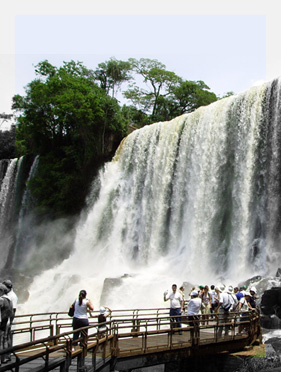
Iguazú National Park (Iguazú Falls) tours
Located in the far northeast of Argentina, in Misiones Province, the Iguazú National Park covers an area of about 67,620 hectares. It was declared a World Heritage Site in 1984 due to the imposing Iguazú Falls, of great scenic beauty, and the biodiversity of the subtropical rainforest.

The Iguazú River runs for 1,320 km until it flows into the Paraná River. The Iguazú River is between 500 and 1,000 metres wide for most of its length. In the National Park area, it grows wider (up to 1,500 metres), winding southward then northward, in a wide U-shaped canyon where the stunning waterfalls are found.
Along the U-shaped Cliff, the River is split into numerous falls by an array of reefs, islets and elongated islands. The Iguazú waterfall system is made up of the individual falls -together with the Garganta del Diablo (Devil’s Throat).
This natural reservoir is the home to:
• An indigenous plant life including over 2,000 species: lush ferns, bromeliads, orchids, palm trees and towering tres supporting a wide range of climbing plants, whose fruits in turn attract monkeys, coatis, deer and tucans, among others.
• 450 bird species, which can be easily spotted in the early morning hours and at sunset. Examples include tucans, magpies, Southern lapwings, parrots and the amazing vencejos, a species unique to the Iguazú Falls area.
• 80 mammal species including five feline species which will blend into the rainforest.
• Countless insects as well as a great number of colourful butterflies.
• Caymans and herons, feeding on smaller fish.

This area has wildlife preservation value. Endangered species protected by the Park include yaguaretés (Pantera onca), ocelotes (Felis pardalis), yacutingas (Aburria jacuntinga), macucos (Tinamus solitarius), just to mention a few.
Iguazú Falls - A memorable experience
The falls are one of the world’s greatest natural wonders and originated some two hundred thousand years ago at the site known today as “the Three Borders Landmark”, where the Iguazú and Paraná Rivers meet.
Geological faulting along the Paraná riverbed created a chasm (80 metres high) into which the Paraná River drains. The point where the Falls originated is 23 km from the Garganta del Diablo (Devil’s Throat), due to the slow yet steady receding process.
The original waterfall has turned into two winding 2,700-metre long arcs. The most impressive fall, Devil’s Throat, is found on the main portion of the river. Between 160 and 260 individual falls may be seen depending on the amount of water pouring into the gorge (averaging 1,500 cubic metres of water per second).
Mist rises from the heavy water beating down below, which creates dazzling rainbows.
The waterfall system is made up of 275 individual falls up to 70 metres high, fed by the Iguazú River. The "Devil’s Throat" is a natural wonder in its own right. Departing from Puerto Canoas, visitors on boat tours can get up close, at a mere 50 metres from the fall. You can even catch a speedboat and experience the falls from underneath.

The various trekking trails or boat tours allow visitors to take in the thundering falls as well as the native animal and plant life.
Iguazú Falls are the main tourist attraction in Northern Argentina, and a major destination nationwide.
The first European to find the massive falls was a Spanish Conquistador, Álvar Núñez Cabeza de Vaca, who led an expedition from Santa Catarina Island to Asunción (Paraguay) in the mid sixteenth century. Cabeza de Vaca called them "Santa María Falls".
![]()
![]()















